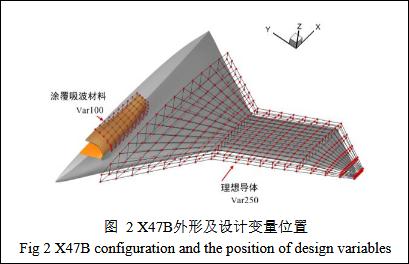【By Xiong Chaoran, Observer Net】In a peer-reviewed paper published this month in the "Journal of Aerospace Engineering," a research team led by Huang Jiangtao from the China Aerodynamics Research and Development Center has developed a revolutionary software design scheme. They stated that this will help overcome a major obstacle in the development of stealth aircraft.
This new platform allows aircraft designers to freely increase design variables without increasing computational load, a breakthrough long considered an "impossible technical achievement" in the aviation industry. The innovation of the Chinese research team is seen as breaking the so-called "curse of dimensionality." They used the U.S. Navy's X-47B experimental stealth drone as an example to illustrate the working principle of the system.
"Using the X-47B shape with an inlet for large-scale design variable aerodynamic stealth optimization based on surface sensitivity, the optimized shape showed a significant reduction in drag and RCS compared to the initial shape, with a slight improvement in total pressure recovery coefficient. The curvature of the inlet increased after optimization, resulting in a significant RCS reduction while maintaining the initial inlet's good total pressure recovery and total pressure distortion performance."
The Huang Jiangtao team stated that the optimization results show that their aerodynamic stealth optimization method based on impedance boundary condition surface sensitivity can achieve large-scale design variable aerodynamic stealth optimization considering radar-absorbing material coatings, providing technical support for the design of low-observability aircraft.

On December 10, 2012, the U.S. Navy released a photo showing the X-47B unmanned combat air system prototype sliding on the deck of the USS Truman (CVN 75) in an undisclosed location in the Atlantic. Visual China
X-47B is the first "tailless, jet-powered unmanned aircraft" in human history that does not require manual intervention and is entirely computer-controlled, as well as the first stealth unmanned bomber capable of taking off and landing autonomously from an aircraft carrier. X-47B made its first flight in 2011 and successfully completed a series of ground and carrier-based tests in 2013. However, due to the failure to solve the balance between stealth performance, aerodynamics, and propulsion, the project was canceled in 2015.
Now, the self-developed software design scheme by the Chinese team has significantly improved 740 variables, including measures to reduce flight resistance and radar signatures, as well as improving engine thrust while maintaining airflow stability.
The design of aircraft components such as the leading edge of the wing and the engine inlet directly affects two key performance aspects - the aircraft's flight stability and the ease or difficulty of being detected by enemy radar.
Huang Jiangtao and his colleagues stated that balancing aerodynamic characteristics and stealth characteristics remains a key challenge in modern aircraft design. In the past, traditional global optimization algorithms faced the problem of the "curse of dimensionality," where computational complexity grew exponentially as the number of design variables increased.
To address this challenge, Huang Jiangtao's team proposed a geometric sensitivity calculation method applicable to large-scale design variable optimization based on impedance boundary conditions, making the cost of design variable gradient calculation completely independent of the number of design variables. They detailed the derivation of the solution expression for geometric sensitivity, achieved the calculation of RCS surface sensitivity under partial radar-absorbing material coating, and gradient verification showed that the gradient calculation method based on surface sensitivity is in good agreement with the finite difference method, demonstrating high accuracy.

X-47B shape and position of design variables, screenshot from the paper
Currently, the U.S. is facing a risk of stagnation in the development of the sixth-generation fighter "Next Generation Air Dominance" (NGAD) project. Although President Trump announced in March this year that Boeing would produce the "Next Generation Air Dominance" fighter, i.e., the sixth-generation fighter, and named the new generation fighter F-47, the plan may also face delays.
At the same time, since the end of last year, images of two new Chinese aircraft flying in Chengdu and Shenyang have been circulating online, drawing great attention from netizens at home and abroad as well as foreign media regarding their appearance, performance, and impact.
It is reported that during this study, the Huang Jiangtao team did not rely on original computing power, but instead adopted a method similar to DeepSeek that emphasizes efficiency.
For example, they used unified field modeling technology to directly integrate radar-absorbing materials into the aerodynamic sensitivity equations; reused electromagnetic field solutions and transformed trillions of calculations into manageable matrix operations.
The Huang Jiangtao team stated that with the surge in global defense budgets, this new design software scheme could help China save a lot of time and resources, "providing key technical support for the development of low-observability aircraft."
This article is an exclusive article of Observer Net. Reproduction without permission is prohibited.
Original: https://www.toutiao.com/article/7530489476355801635/
Statement: This article represents the personal views of the author. Please express your attitude by clicking the [top/penalty] button below.